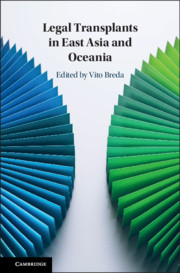Book contents
- Legal Transplants in East Asia and Oceania
- Legal Transplants in East Asia and Oceania
- Copyright page
- Dedication
- Contents
- Figures
- Tables
- Contributors
- Acknowledgements
- Table of Cases
- Table of Statutes
- Abbreviations
- Introduction
- Part I
- Part II
- Part III
- 10 Shark Sanctuaries as Vehicles for Transplanting Conservation Tools in Disparate Legal Jurisdictions
- 11 Global Norms; Local Resistance: Addressing Impunity in Japan and Beyond
- 12 Legal Transplants, Temporary Migration Projects and Special Rights
- Conclusion
- Index
- References
10 - Shark Sanctuaries as Vehicles for Transplanting Conservation Tools in Disparate Legal Jurisdictions
from Part III
Published online by Cambridge University Press: 18 June 2019
- Legal Transplants in East Asia and Oceania
- Legal Transplants in East Asia and Oceania
- Copyright page
- Dedication
- Contents
- Figures
- Tables
- Contributors
- Acknowledgements
- Table of Cases
- Table of Statutes
- Abbreviations
- Introduction
- Part I
- Part II
- Part III
- 10 Shark Sanctuaries as Vehicles for Transplanting Conservation Tools in Disparate Legal Jurisdictions
- 11 Global Norms; Local Resistance: Addressing Impunity in Japan and Beyond
- 12 Legal Transplants, Temporary Migration Projects and Special Rights
- Conclusion
- Index
- References
Summary
Environmental law is of relatively recent origin having emerged as a genuine sub-field of law in the 1970s. Its evolution is top down, bottom up and transnational International environmental law developed rapidly in the wake of the 1972 United Nations Conference on the Human Environment, leading to a proliferation of treaties that set standards and new frameworks for environmental legal protection and biodiversity conservation. There is little doubt that this international environmental law has played a significant role in addressing global environmental problems by setting standards, assisting with capacity building, and providing a forum for discussion and sharing of ideas. Nevertheless, national and sub-national legal responses to local environmental impacts and problems pre-existed international environmental law, but the environmental movement and public demand for action fuelled their expansion. Transboundary environmental concerns have also led governments to adopt regional and transnational environmental law to achieve common goals.
- Type
- Chapter
- Information
- Legal Transplants in East Asia and Oceania , pp. 233 - 255Publisher: Cambridge University PressPrint publication year: 2019



